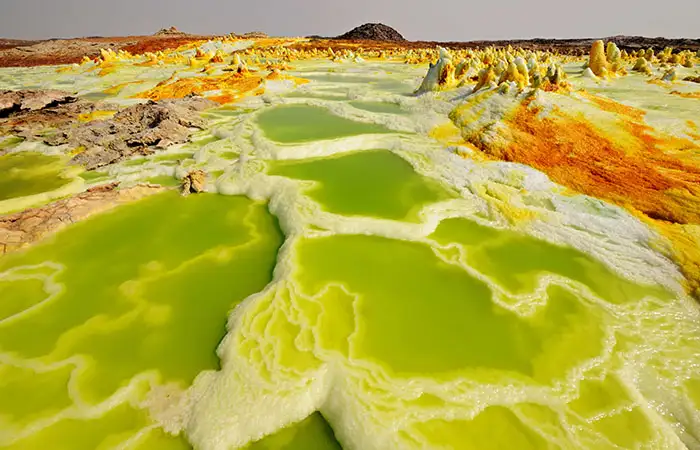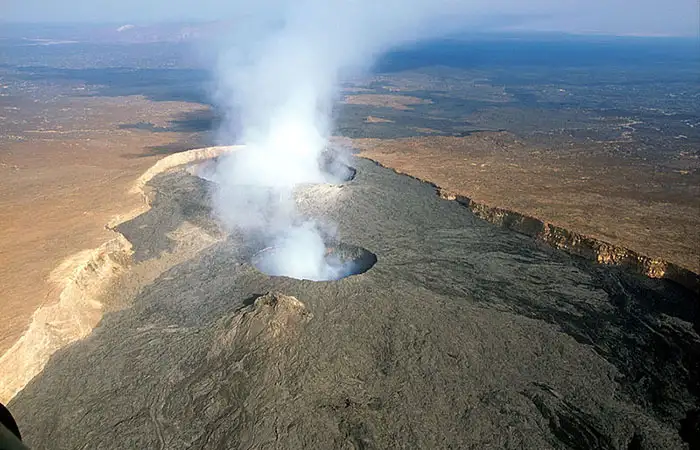Natural Attractions of Ethiopia

Danakil Depression
The Danakil Depression marks the northern end of the Great Rift Valley on the African mainland, the point where Earth’s forces are most actively tearing the continent apart.It is a desert region in the Afar region of northeastern Ethiopia. It is an extremely arid, hot lava spilling out in colourful splashes desert area which stretches from the coastline of Eritrea through north-eastern Ethiopia and western parts of Djibouti. The heat of the lava lake feeds sulfuric springs which gives a brilliant technicolor landscape of incredible blues, greens, and browns. The Danakil Depression is actually one of the lowest points on earth, beneath sea level, not covered in water. Here, in relatively close proximity, geological features associated with the splitting of continental land masses are clearly seen, including intense volcanic activity (with one of the few permanent lava lakes on the planet on Mount Erta Ale), hot sulphur springs elaborately decorated with extraordinary coral-like formations as well as salt-encrusted lake beds.The best time to visit it is when it is coolest between November to early January as it’s one of the hottest places on earth.

Erta Ale Volcano
Erta Ale volcano is a large basaltic shield volcano in the Erta Ale volcanic range in the central northern Danakil depression. It is famed for its persistent lava lake which has been active during most of the past decades since it was first discovered in the 1960s. Erta Ale is only 613 m high, but as typical for a shield volcano has a very gentle slopes and a large 40 km diameter base. The summit is truncated by a complex, elongated 1700 x 600 m wide caldera which contains vast lava flows and several larger and smaller pit craters, most notably the active north and south crater, which contains the lava lake at present. Erta Ale is one of the main attractions of the Danakil, and had become a popular tour destination in recent years.

Bale Mountains
It is located 400 km south east of Addis Ababa. Located in the Oromia Region of southeast Ethiopia, the Bale Mountain National Park is one of those landscapes that keeps you guessing. Bale Mountains National Park contains a spectacular diverse landscape, the high altitude, Afro-Montana plateau rises to over 4000 m and includes the highest peaks in the southern Ethiopia highlands. This undulating plateau is marked by numerous glacial lakes and swamps and surrounded by higher volcanic ridges and peaks. The park is rich in birds and endemic animals like the Nyala. It also has all the levels of vegetation from grasslands to thick forests. The southern slopes are covered by the lush and largely UN explored Harenna forest. It is a good place for hikers, wildlife watchers, culture and nature enthusiasts, and bird watchers, horseback and go fishing. The best time to visit the park is November to March but be prepared as the nights can get to below freezing temperatures.

Simien Mountains National Park
The Simien Mountains National Park is a UNESCO World Heritage Site situated in Northen Ethiopia near Debark where the park Head Quarters are located. The park was made a world heritage site in 1978. The park holds the highest mountain in Ethiopia; Ras Dashen which stands at 4535m. The high altitude of the ridge means the climate is quite cool allowing a number of species to live which are found no where else on earth. some of the most unique vegetation and wildlife you will ever see. Vegetation like the Erica tree and species like the ibex, Simien wolf and Geleda baboon are endemic to this area. The best time to visit the mountains are from September to November after the summer rains.These seasons give a great view of lush vegetation.
